ZyXEL Communications B-120 802.11b Mobile Module User Manual ZyAIR Wireless Utility OEM
ZyXEL Communications Corporation 802.11b Mobile Module ZyAIR Wireless Utility OEM
Contents
- 1. DoC Statement
- 2. Users Manual Revised 052203
- 3. Quick Install Guide
- 4. Revised Installation Guide
Revised Installation Guide

Wireless LAN Utility
User's Guide
Version 2.0
September 2003
Note to OEMs: ZyXEL provides this document as a sample User’s Guide. This User’s Guide may require
customization to reflect your own company name, product name and/or document style.
Possible words you may want to change: OEM, WLAN Adapter, WLAN Utility

Wireless LAN Utility
ii Copyright
Copyright
Copyright ©2003 by the Original Equipment Manufacturer (OEM)
The contents of this publication may not be reproduced in any part or as a whole, transcribed, stored in a
retrieval system, translated into any language, or transmitted in any form or by any means, electronic,
mechanical, magnetic, optical, chemical, photocopying, manual, or otherwise, without the prior written
permission of the OEM.
Published by the OEM. All rights reserved.
Disclaimer
The OEM does not assume any liability arising out of the application or use of any products, or software
described herein. Neither does it convey any license under its patent rights nor the patents' rights of others.
The OEM further reserves the right to make changes in any products described herein without notice. This
publication is subject to change without notice.
Trademarks
Trademarks mentioned in this publication are used for identification purposes only and may be properties
of their respective owners.

Wireless LAN Utility
Limited Warranty iii
Limited Warranty

Wireless LAN Utility
iv Information for Canadian Users
Information for Canadian Users
The Industry Canada label identifies certified equipment. This certification means that the equipment meets
certain telecommunications network protective operation and safety requirements. The Industry Canada
does not guarantee that the equipment will operate to a user's satisfaction.
Before installing this equipment, users should ensure that it is permissible to be connected to the facilities
of the local telecommunications company. The equipment must also be installed using an acceptable
method of connection. In some cases, the company's inside wiring associated with a single line individual
service may be extended by means of a certified connector assembly. The customer should be aware that
compliance with the above conditions may not prevent degradation of service in some situations.
Repairs to certified equipment should be made by an authorized Canadian maintenance facility designated
by the supplier. Any repairs or alterations made by the user to this equipment, or equipment malfunctions,
may give the telecommunications company cause to request the user to disconnect the equipment.
For their own protection, users should ensure that the electrical ground connections of the power utility,
telephone lines, and internal metallic water pipe system, if present, are connected together. This precaution
may be particularly important in rural areas.
Caution
Users should not attempt to make such connections themselves, but should contact the appropriate
electrical inspection authority, or electrician, as appropriate.
Note
This digital apparatus does not exceed the Class B limits for radio noise emissions from digital apparatus
set out in the radio interference regulations of Industry.

Wireless LAN Utility
FCC Statement v
Federal Communications Commission
(FCC) Interference Statement
This device complies with Part 15 of FCC rules. Operation is subject to the following two conditions:
1. This device may not cause harmful interference.
2. This device must accept any interference received, including interference that may cause undesired
operations.
This equipment has been tested and found to comply with the limits for a CLASS B digital device pursuant
to Part 15 of the FCC Rules. These limits are designed to provide reasonable protection against harmful
interference in a commercial environment. This equipment generates, uses, and can radiate radio frequency
energy, and if not installed and used in accordance with the instructions, may cause harmful interference to
radio communications.
If this equipment does cause harmful interference to radio/television reception, which can be determined by
turning the equipment off and on, the user is encouraged to try to correct the interference by one or more of
the following measures:
• Reorient or relocate the receiving antenna.
• Increase the separation between the equipment and the receiver.
• Connect the equipment into an outlet on a circuit different from that to which the receiver is
connected.
• Consult the dealer or an experienced radio/TV technician for help.
Caution
This device is intended only for OEM integrators under the following conditions:
1. This equipment complies with FCC radiation exposure limits set forth for an uncontrolled
environment. In order to avoid the possibility of exceeding the FCC radio frequency exposure limits,
human proximity to the antenna (installed to end product) shall not be less than 20 cm (8 inches)
during normal operation.
2. This Transmitter must not be co-located or operating in conjunction with any other antenna or
transmitter
As long as the 2 conditions above are met, further transmitter testing will not be required. However, the
OEM integrator is still responsible for testing their end-product for any additional compliance requirements
required with this module installed (for example, digital device emission, PC peripheral requirements, etc.).
Notice 1
Changes or modifications not expressly approved by the party responsible for compliance could void the
user's authority to operate the equipment.
Additional Information to OEM Integrators

Wireless LAN Utility
vi FCC Statement
The end user should NOT be provided any instructions on how to remove or install the device.
End Product Labeling
This transmitter module is authorized only for use in devices where the antenna may be installed such that
20 cm may be maintained between the antenna and users (for example access points, routers, wireless
ASDL modems, and similar equipment). The final end product must be labeled in a visible area with the
following: Contains TX FCC ID: I88B-120
IMPORTANT NOTE
1. In the event that these conditions can not be met (for example certain laptop configurations or co-
location with another transmitter), then the FCC authorization is no longer considered valid and the
FCC ID can not be used on the final product. In these circumstances, the OEM integrator will be
responsible for re-evaluating the end product (including the transmitter) and obtaining a separate FCC
authorization.
2. To comply with FCC RF exposure compliance requirements, the antenna used for this transmitter must
be installed to provide a separation distance of at least 20 cm from all persons and must not be co-
located or operating in conjunction with any other antenna or transmitter."
Certifications
Refer to the product page at OEM web site.

Wireless LAN Utility
Customer Support vii
Customer Support
When contacting your Customer Support Representative, please have the following information ready:
Product model and serial number.
Warranty Information.
Date you received your product.
Brief description of the problem and the steps you took to solve it.
METHOD
LOCATION
E-MAIL
SUPPORT/SALES
TELEPHONE/FAX WEB SITE/ FTP SITE REGULAR MAIL

Wireless LAN Utility
Table of Contents ix
Table of Contents
Copyright.......................................................................................................................................................ii
Limited Warranty........................................................................................................................................iii
Information for Canadian Users.................................................................................................................iv
Federal Communications Commission (FCC) Interference Statement.................................................... v
Customer Support.......................................................................................................................................vii
List of Figures...............................................................................................................................................xi
List of Tables ................................................................................................................................................xi
Preface..........................................................................................................................................................xii
Chapter 1 Wireless Network Basics .........................................................................................................1-1
1.1 Introduction..................................................................................................................................1-1
1.2 Benefits of a Wireless LAN .........................................................................................................1-1
1.3 Applications .................................................................................................................................1-1
1.3.1 Ad-hoc..................................................................................................................................1-1
1.3.2 Infrastructure........................................................................................................................1-2
Chapter 2 Disable Windows XP Configuration Tool..............................................................................2-1
Chapter 3 Using the Wireless LAN Utility...............................................................................................3-1
3.1 Accessing the WLAN Utility .......................................................................................................3-1
3.2 Viewing Current Configuration ...................................................................................................3-1
3.2.1 Common Screen Command Buttons ....................................................................................3-3
3.3 The About Screen.........................................................................................................................3-3
3.4 Wireless LAN Parameters............................................................................................................3-5
3.4.1 SSID.....................................................................................................................................3-5
3.4.2 Channel ................................................................................................................................3-5
3.4.3 Tx Rate.................................................................................................................................3-5
3.5 Wireless Network Type................................................................................................................3-5
3.5.1 Ad-Hoc (IBSS).....................................................................................................................3-5
3.5.2 Infrastructure........................................................................................................................3-6
3.6 Roaming.......................................................................................................................................3-7
3.7 The Site Survey Screen ................................................................................................................3-8
3.7.1 Connecting to a Network....................................................................................................3-10
3.8 Configuring the Wireless Parameters.........................................................................................3-11
3.9 Network Configuration Profile Setting ......................................................................................3-12
3.9.1 Resetting to Factory Default Values ..................................................................................3-12
3.9.2 Saving the Current Setting to a Profile...............................................................................3-13
3.9.3 Using a Pre-configured Profile...........................................................................................3-13
3.9.4 Deleting a Profile ...............................................................................................................3-13
Chapter 4 Wireless LAN Security ............................................................................................................4-1
4.1 Introduction..................................................................................................................................4-1
4.2 Data Encryption with WEP..........................................................................................................4-1

Wireless LAN Utility
x Table of Contents
4.2.1 Authentication Mode ...........................................................................................................4-1
4.2.2 Configuring the WEP Encryption ........................................................................................4-1
Chapter 5 Advanced Configuration.........................................................................................................5-1
5.1 Overview......................................................................................................................................5-1
5.1.1 Threshold Control ................................................................................................................5-1
5.1.2 Authentication Mode ...........................................................................................................5-2
5.1.3 Preamble Type .....................................................................................................................5-2
5.2 The Advanced Screen ..................................................................................................................5-3
Chapter 6 Removing and Upgrading the WLAN Utility........................................................................6-1
6.1 Removing the WLAN Utility.......................................................................................................6-1
6.2 Upgrading the WLAN Utility ......................................................................................................6-1
Chapter 7 Troubleshooting .......................................................................................................................7-1
7.1 Problems Starting the WLAN Utility Program............................................................................7-1
7.2 Problems Communicating With Other Computers ......................................................................7-2
7.3 Problem with the Link Status.......................................................................................................7-2
Index ............................................................................................................................................................. A

Wireless LAN Utility
List of Figures/Tables xi
List of Figures
Figure 1-1 Ad-hoc Application Example .....................................................................................................1-2
Figure 1-2 Infrastructure Application Example............................................................................................1-2
Figure 2-1 Windows XP: System Tray Icon.................................................................................................2-1
Figure 2-2 Windows XP: Wireless Network Connection Status ..................................................................2-2
Figure 2-3 Windows XP: Connect to Wireless Network..............................................................................2-2
Figure 2-4 Windows XP: Wireless Network Connection Properties............................................................2-3
Figure 3-1 WLAN Utility System Tray Icon................................................................................................3-1
Figure 3-2 WLAN Utility: WLAN Status ....................................................................................................3-2
Figure 3-3 WLAN Utility: About.................................................................................................................3-4
Figure 3-4 Ad-hoc Network Example ..........................................................................................................3-6
Figure 3-5 BSS Example..............................................................................................................................3-6
Figure 3-6 Infrastructure Network Example ................................................................................................3-7
Figure 3-7 Roaming Example ......................................................................................................................3-8
Figure 3-8 WLAN Utility: Site Survey ........................................................................................................3-9
Figure 3-9 Site Survey Warning.................................................................................................................3-10
Figure 3-10 WLAN Utility: Network Configuration .................................................................................3-11
Figure 4-1 WLAN Utility: Security .............................................................................................................4-2
Figure 5-1 RTS Threshold............................................................................................................................5-1
Figure 5-2 WLAN Utility: Advanced...........................................................................................................5-3
List of Tables
Table 3-1 System Tray Icon Description......................................................................................................3-1
Table 3-2 WLAN Utility: WLAN Status......................................................................................................3-2
Table 3-3 Common Screen Command Buttons............................................................................................3-3
Table 3-4 WLAN Utility: About ..................................................................................................................3-4
Table 3-5 WLAN Utility: Site Survey..........................................................................................................3-9
Table 3-6 Color Indicator for Link Quality/Link Strength .........................................................................3-10
Table 3-7 WLAN Utility: Network Configuration.....................................................................................3-12
Table 4-1 WLAN Utility: Security...............................................................................................................4-2
Table 5-1 WLAN Utility: Advanced ............................................................................................................5-4
Table 7-1 Troubleshooting Starting WLAN Utility Program .......................................................................7-1
Table 7-2 Troubleshooting Communication Problems.................................................................................7-2
Table 7-3 Troubleshooting Link Quality......................................................................................................7-2

Wireless LAN Utility
xii Preface
Preface
Congratulations on the purchase of your new Wireless LAN Adapter!
About This User's Guide
A practical and comprehensive tool, this guide provides information about the Wireless LAN Utility
operation.
This guide is for wireless devices that uses the Wireless LAN Utility program, thus the model name shown
in the screens may vary from what you actually purchased.
Familiarize yourself with the Syntax Conventions listed for better and faster understanding.
Related Documentation
Support Disk
Refer to the included CD for support documents and device drivers.
Quick Installation Guide
Our Quick Installation Guide is designed to help you get your Wireless LAN Adapter up and
running right away. It contains a detailed easy-to-follow connection diagram and information on
installing your Wireless LAN Adapter.
Glossary and Web Site
Please refer to OEM web site for an online glossary of networking terms and additional support
documentation.
Syntax Conventions
• “Type” or “Enter” means for you to type one or more characters. "Select" or "Choose" means for
you to use one of the predefined choices.
• Window and command choices are in Bold Times New Roman font. Predefined field choices are
in Bold Arial font.
• The Wireless LAN Adapter is referred to as the WLAN Adapter or, simply, as the Adapter in this
guide.
• The Wireless LAN Utility may be referred to as the WLAN Utility in this guide.

Wireless LAN Utility
Wireless Network Basics 1-1
Chapter 1
Wireless Network Basics
This chapter gives you an overview of what a wireless network is, its advantages and
applications.
1.1 Introduction
A wireless LAN (WLAN) provides a flexible data communication system that you can use to access
various services (navigating the Internet, email, printer services, etc.) on the wired network without
additional expensive network cabling infrastructure. In effect, a wireless LAN environment provides you
the freedom to stay connected to the wired network while moving in the coverage area.
1.2 Benefits of a Wireless LAN
Access to network services in areas otherwise hard or expensive to wire, such as historical
buildings, buildings with asbestos materials and classrooms.
Doctors and nurses can access a complete patient’s profile on a handheld or notebook computer
upon entering a patient’s room.
It allows flexible workgroups a lower total cost of ownership for networks that are frequently
reconfigured.
Conference room users can access the network as they move from meeting to meeting- accessing
up-to-date information that facilitates the ability to communicate decisions “on the fly”.
It provides campus-wide networking coverage, allowing enterprises the roaming capability to set
up easy-to-use wireless networks that transparently covers an entire campus.
1.3 Applications
Unlike wired networks, you can set up wireless networks in two different modes: infrastructure and ad-hoc.
Set up your wireless network depending on your network needs. The following sections describe each
network mode.
1.3.1 Ad-hoc
An ad-hoc network consists of two or more computers communicating with one another through the
wireless network. No access points (APs) or existing wired networks are needed. An access point acts as a
bridge between the wireless and wired networks
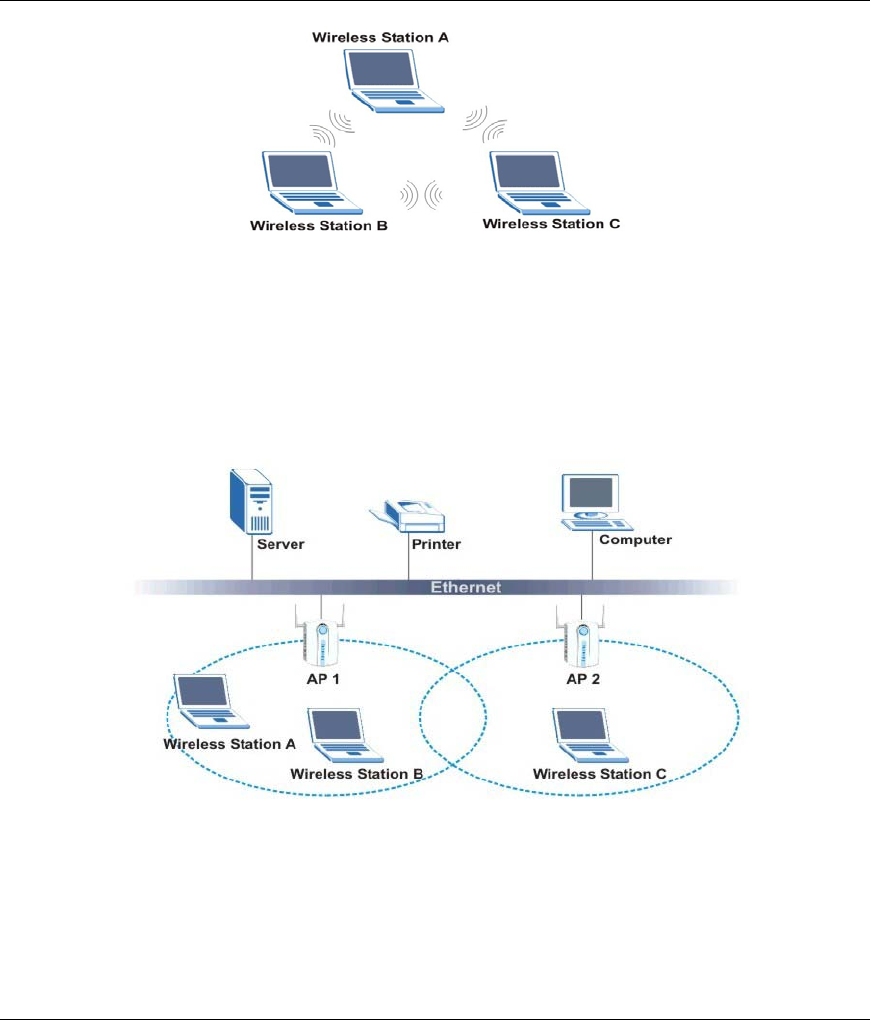
Wireless LAN Utility
1-2 Wireless Network Basics
Figure 1-1 Ad-hoc Application Example
1.3.2 Infrastructure
When wireless clients wish to access and share resources on the wired network, they should use
infrastructure mode. Wireless clients may move from one coverage area to another seamlessly without
network interruption. This is called roaming.
The figure below depicts an infrastructure network example
Figure 1-2 Infrastructure Application Example
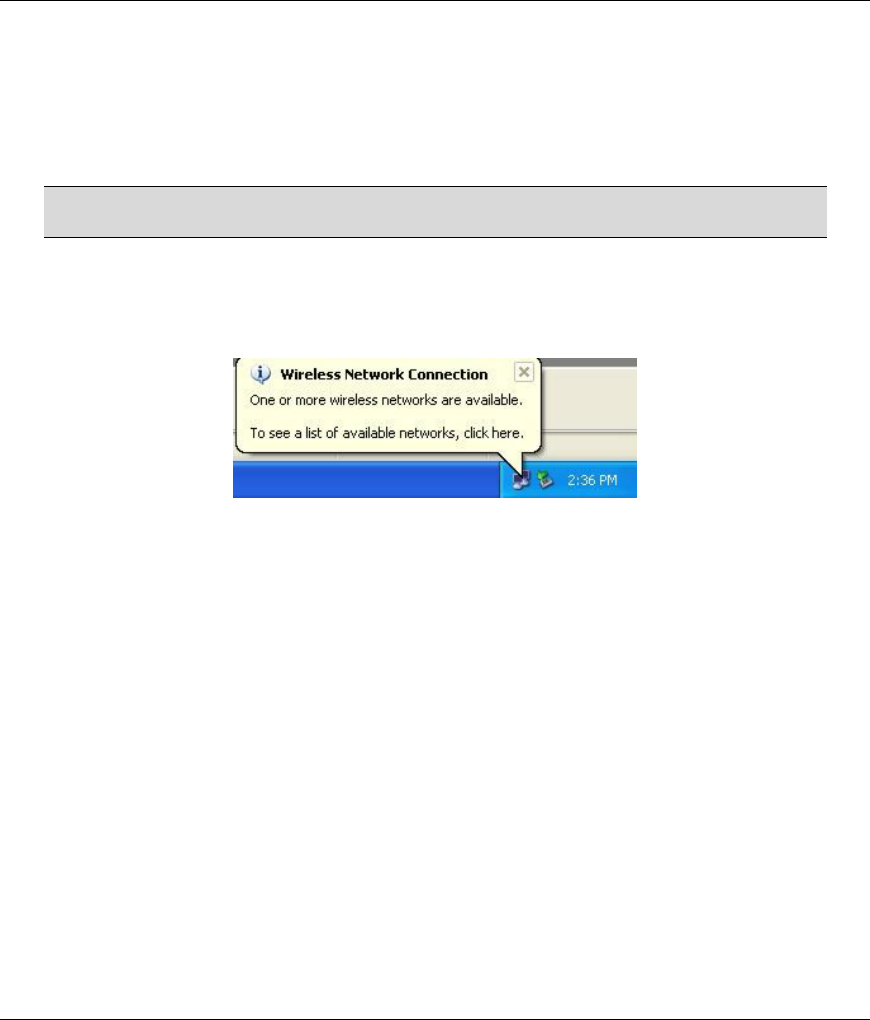
Wireless LAN Utility
Disable Windows XP 2-1
Chapter 2
Disable Windows XP Configuration Tool
Windows XP includes a basic configuration tool for wireless devices.
DO NOT use the Windows XP configuration tool together with the WLAN Utility. It
is recommended you use the WLAN Utility to configure the WLAN Adapter.
Follow the steps below to disable the configuration tool in Windows XP after you install the WLAN
Utility.
Step 1. Double-click on the network icon for wireless connection in the system tray. Proceed to Step 2
if the icon is not present. Otherwise go to Step 5.
Figure 2-1 Windows XP: System Tray Icon
Step 2. If the icon for the wireless network connection is not in the system tray, click start, Control
Panel and double-click on Network Connections.
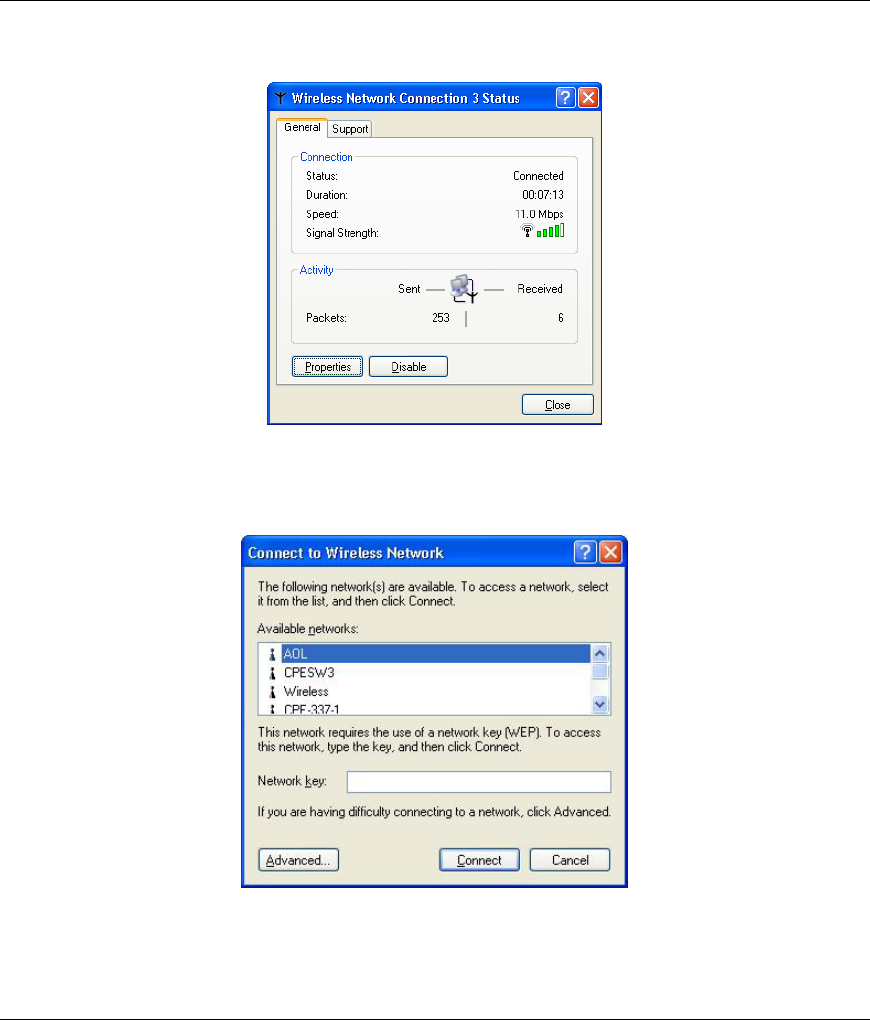
Wireless LAN Utility
2-2 Disable Windows XP
Step 3. Double-click on the icon for wireless network connection to display a status window as shown
next.
Figure 2-2 Windows XP: Wireless Network Connection Status
Step 4. Click Properties and click the Wireless Networks tab. Then go to Step 6.
Step 5. When a Connect to Wireless Network window displays, click Advanced….
Figure 2-3 Windows XP: Connect to Wireless Network
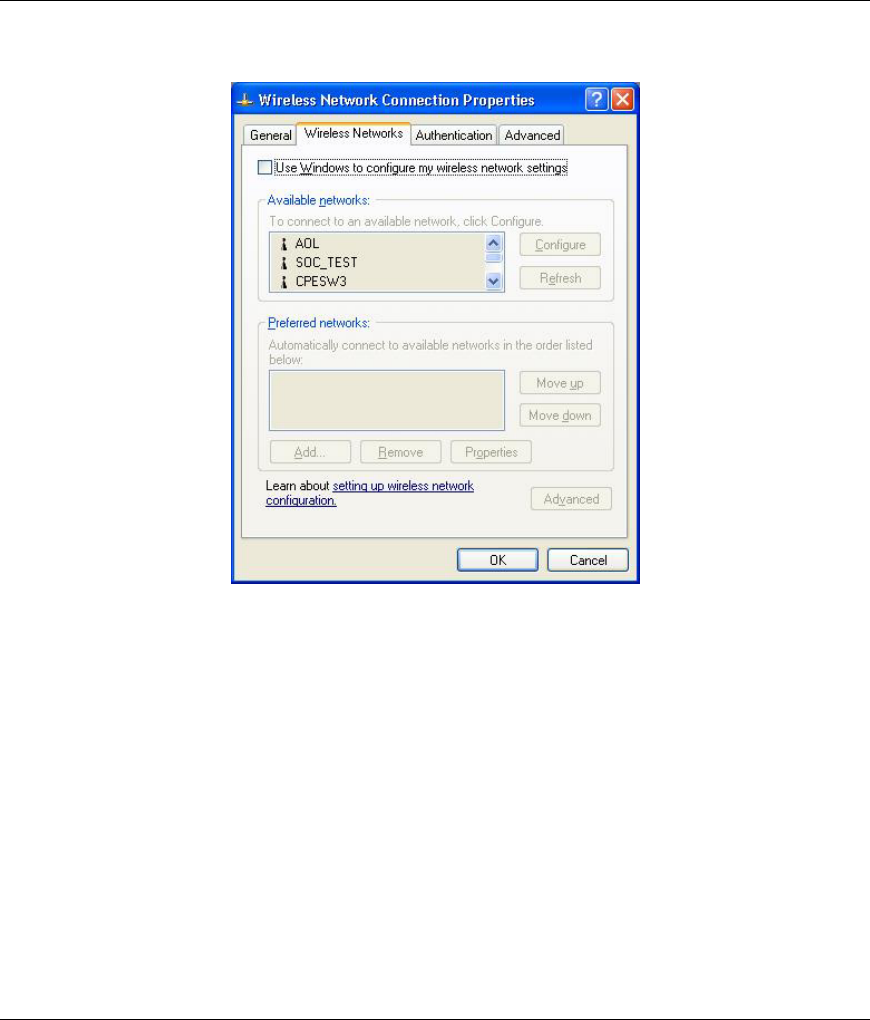
Wireless LAN Utility
Disable Windows XP 2-3
Step 6. In the Wireless Network Connection Properties window, make sure the Use Windows to
configure my wireless network settings check box is not selected. Click OK.
Figure 2-4 Windows XP: Wireless Network Connection Properties
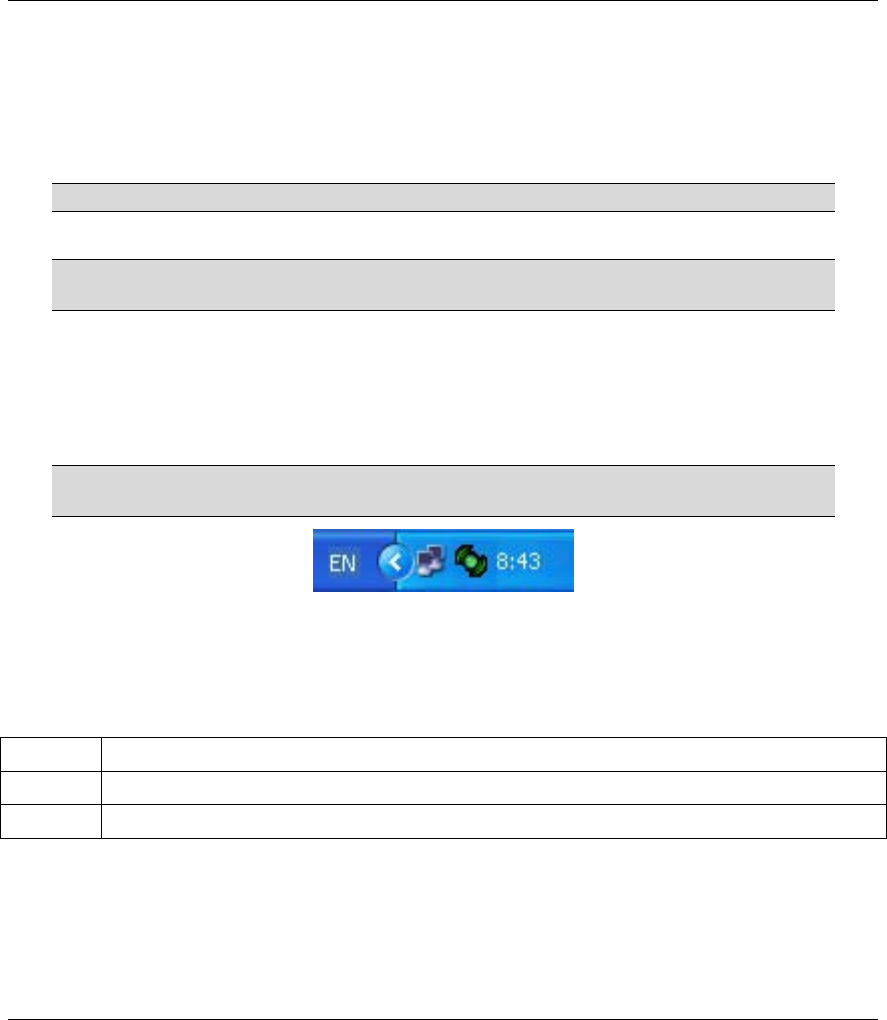
Wireless LAN Utility
Using the Wireless LAN Utility 3-1
Chapter 3
Using the Wireless LAN Utility
This chapter shows you basic wireless LAN configuration using the Wireless LAN Utility.
Install the WLAN Adapter before you proceed. Refer to the Quick Installation Guide.
For Windows XP users: disable the Windows XP wireless configuration tool first
before you proceed. Refer to Chapter 2.
Screen shots for Windows XP are shown unless otherwise specified.
3.1 Accessing the WLAN Utility
After the Wireless LAN Utility is installed, an icon appears in the system tray.
If the WLAN Utility system tray icon displays, the WLAN Adapter is installed
properly.
Figure 3-1 WLAN Utility System Tray Icon
The color of the WLAN Utility system tray icon indicates the status of the WLAN Adapter. Refer to the
following table for details.
Table 3-1 System Tray Icon Description
COLOR DESCRIPTION
Yellow The WLAN Adapter is working properly but is not connected to any AP or wireless station.
Green The WLAN Adapter is connected to a wireless network.
Double click on the Wireless LAN Utility icon in the system tray to open the WLAN Utility.
3.2 Viewing Current Configuration
When the WLAN Utility starts, the WLAN Status screen displays, showing the current configuration of
your WLAN Adapter.
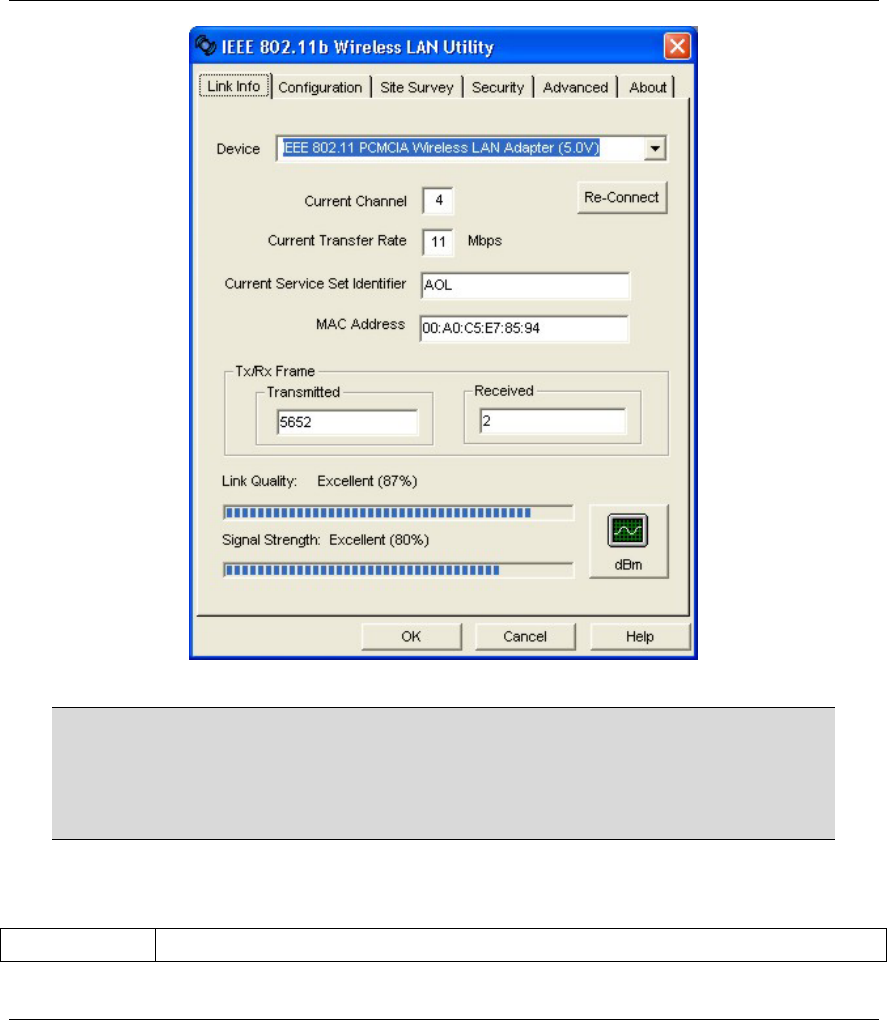
Wireless LAN Utility
3-2 Using the Wireless LAN Utility
Figure 3-2 WLAN Utility: WLAN Status
When the WLAN Adapter is turned on for the first time, the WLAN Adapter
automatically scans and connects to a network with the best link quality and link
strength.
Once you connect to a wireless network, the WLAN Adapter will connect to that
network each time the WLAN Adapter is turned on.
The following table describes the labels in this screen.
Table 3-2 WLAN Utility: WLAN Status
LABEL DESCRIPTION

Wireless LAN Utility
Using the Wireless LAN Utility 3-3
Table 3-2 WLAN Utility: WLAN Status
LABEL DESCRIPTION
Device Select an available wireless card from the drop-down list menu if you have more than
one wireless cards in your computer.
Re-Connect Click Re-Connect to re-establish connection to the wireless device whose SSID is
shown in the Current Service Set Identifier field.
Current Channel This field displays the radio channel the WLAN Adapter is currently using.
Current Transfer
Rate
This field displays the current transmission rate of the WLAN Adapter in megabits per
second.
Current Service
Set Identifier
This field displays the name of the wireless device to which the WLAN Adapter is
associated.
Tx/Rx Frame
Transmitted This field displays the number of data frames transmitted.
Received This field displays the number of data frames received.
Link Quality The status bar and the percentage number show the quality of the signal.
Link Strength The status bar and the percentage number or a number in dBm show the strength of the
signal.
Percent/dBm Click this button to display either percentages in the Link Quality and Link Strength
fields or a number in dBm in the Link Strength field.
3.2.1 Common Screen Command Buttons
The following table describes common command buttons on all WLAN Utility screens.
Table 3-3 Common Screen Command Buttons
BUTTON DESCRIPTION
OK Click OK to save all changes and close the WLAN Utility.
Cancel Click Cancel to discard changes and close the WLAN Utility.
Help Click Help to display the on-line help window.
3.3 The About Screen
The About screen displays related version numbers of the WLAN Adapter. You may click Help to view
related help topics.
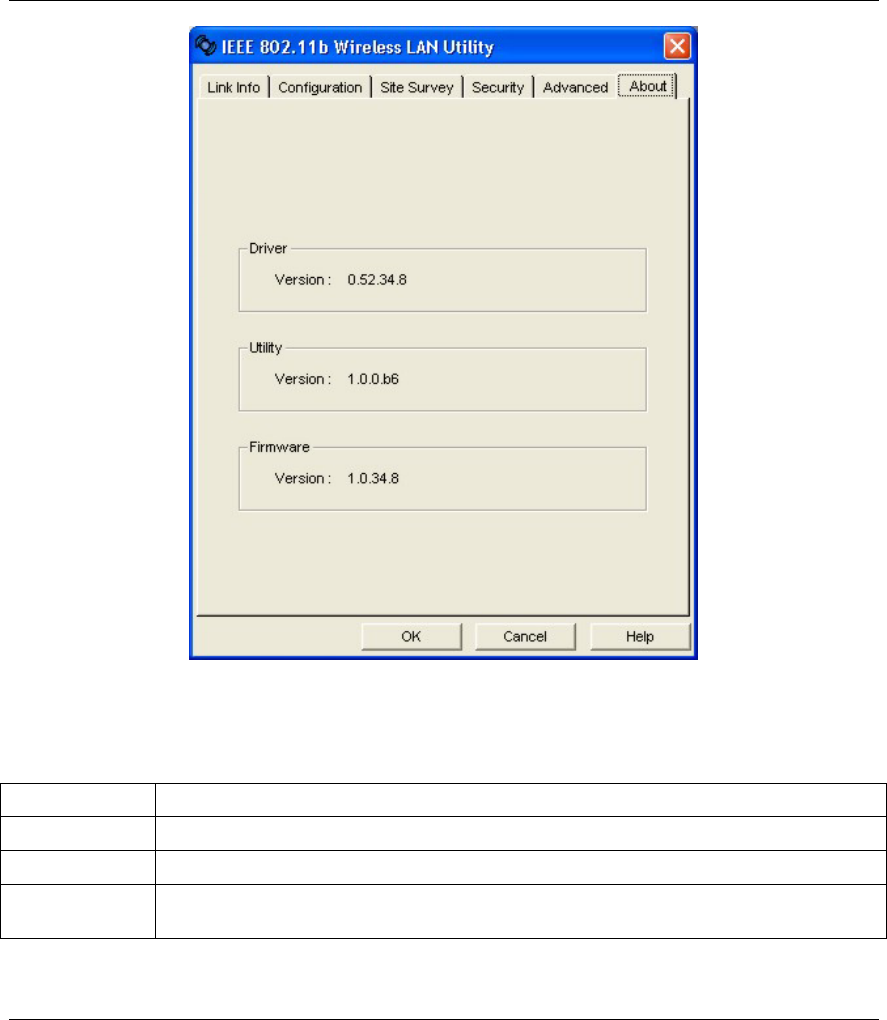
Wireless LAN Utility
3-4 Using the Wireless LAN Utility
Figure 3-3 WLAN Utility: About
The following table describes the read-only labels in this screen.
Table 3-4 WLAN Utility: About
FIELD DESCRIPTION
Driver Version This field displays the version number of the WLAN Adapter’s driver.
Utility Version This field displays the version number of the WLAN Utility.
Firmware
Version
This field displays the version of the firmware on which the driver and the utility are
based.

Wireless LAN Utility
Using the Wireless LAN Utility 3-5
3.4 Wireless LAN Parameters
This section describes each wireless LAN parameter.
3.4.1 SSID
The SSID (Service Set IDentity) is a unique name shared among all wireless devices in a wireless network.
Wireless devices must have the same SSID to communicate with each other.
3.4.2 Channel
A range of radio frequencies used by IEEE 802.11b wireless devices is called a channel.
3.4.3 Tx Rate
The WLAN Adapter provides various transmission (data) rate options for you to select. Options include
Fully Auto, 1 M bit/sec, 2 M bit/sec, 5.5M bit/sec and 11M bit/sec. In most networking scenarios, the
factory default Fully Auto setting proves the most efficient. This setting allows your WLAN Adapter to
operate at the maximum transmission (data) rate. When the communication quality drops below a certain
level, the WLAN Adapter automatically switches to a lower transmission (data) rate. Transmission at lower
data speeds is usually more reliable. However, when the communication quality improves again, the
WLAN Adapter gradually increases the transmission (data) rate again until it reaches the highest available
transmission rate.
If you wish to balance speed versus reliability, you can select any of the above options 11M bit/sec or
5.5M bit/sec is used in a networking environment where you are certain that all wireless devices can
communicate at the highest transmission (data) rate. 1M bit/sec or 2M bit/sec are used often in networking
environments where the range of the wireless connection is more important than speed.
3.5 Wireless Network Type
Wireless LAN works in either of the two modes: ad-hoc and infrastructure.
To connect to a wired network within a coverage area using Access Points (APs), set the WLAN Adapter’s
operation mode to Infrastructure. An AP acts as a bridge between the wireless stations and the wired
network. In case you do not wish to connect to a wired network, but prefer to set up a small independent
wireless workgroup without an AP, use the Ad-hoc (IBSS) (Independent Basic Service Set) mode.
3.5.1 Ad-Hoc (IBSS)
Ad-hoc mode does not required an AP or a wired network. Two or more wireless clients communicate
directly to each other. An ad-hoc network may sometimes be referred to as an Independent Basic Service
Set (IBSS).
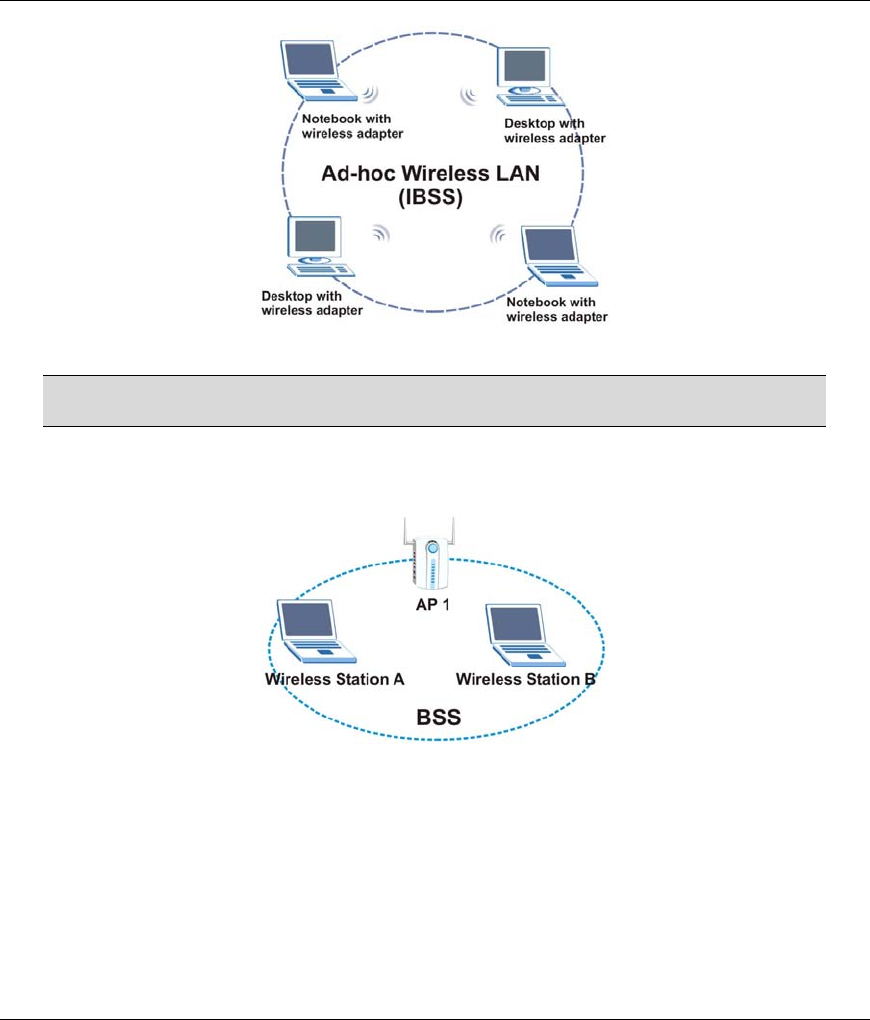
Wireless LAN Utility
3-6 Using the Wireless LAN Utility
Figure 3-4 Ad-hoc Network Example
To set up an ad-hoc network, configure all wireless clients in ad-hoc network type
and use the same SSID and channel.
3.5.2 Infrastructure
When a number of wireless clients are connected using a single AP, you have a Basic Service Set (BSS).
Figure 3-5 BSS Example
A series of overlapping BSS and a network medium, such as an Ethernet forms an Extended Service Set
(ESS) or infrastructure network. All communication is done through the AP, which relays data packets to
other wireless clients or devices connected to the wired network. Wireless clients can then access resource,
such as the printer, on the wired network.
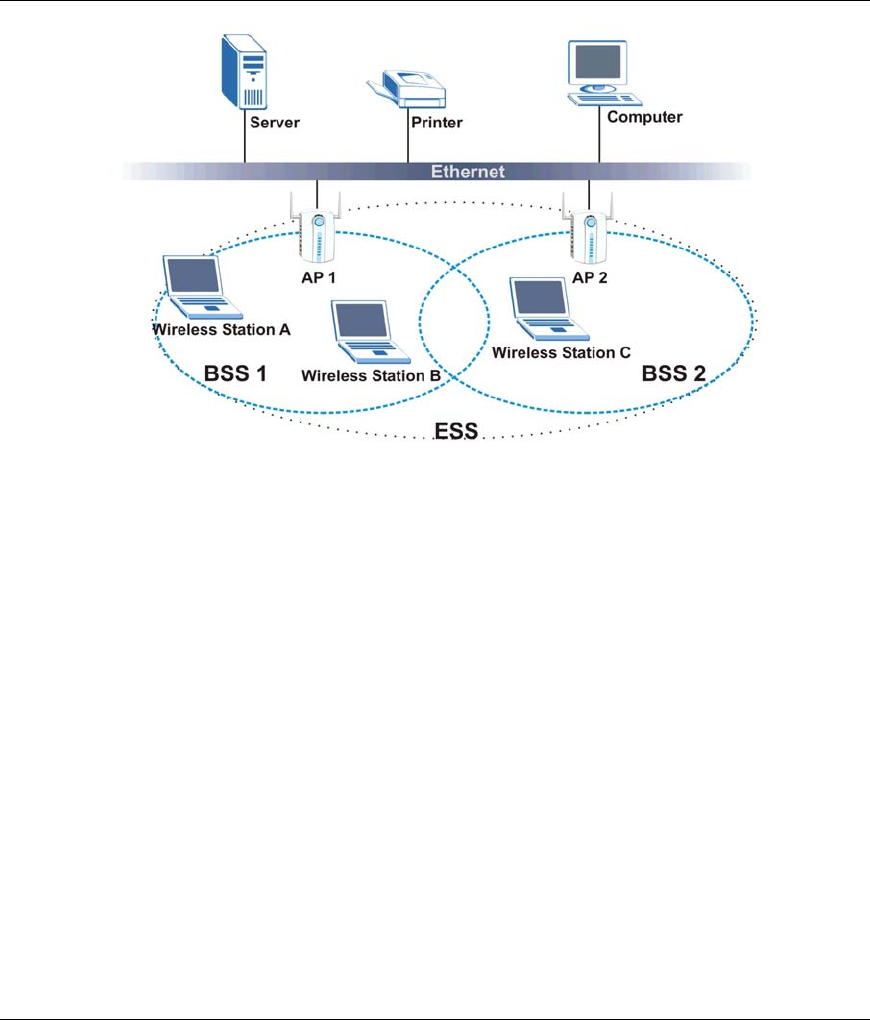
Wireless LAN Utility
Using the Wireless LAN Utility 3-7
Figure 3-6 Infrastructure Network Example
3.6 Roaming
In an infrastructure network, wireless clients are able to switch from one AP to another as they move
between the coverage areas. During this period, the wireless client maintains uninterrupted connection to
the network. This is roaming. As the wireless client moves from place to place, it is responsible for
choosing the most appropriate AP depending on the signal strength, network utilization or other factors.
The following figure depicts a roaming example. When Wireless Client B moves to position X, the
WLAN Adapter in Wireless Client B automatically switches the channel to the one used by Access Point
2 in order to stay connected to the network.
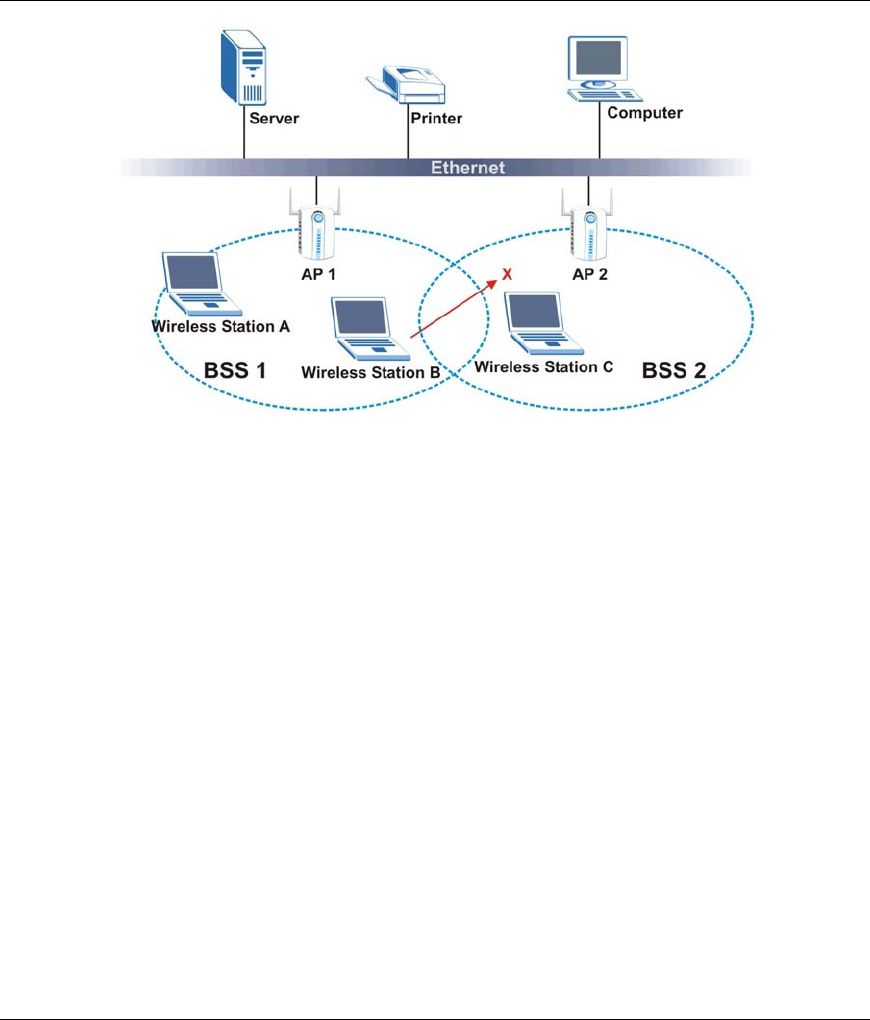
Wireless LAN Utility
3-8 Using the Wireless LAN Utility
Figure 3-7 Roaming Example
3.7 The Site Survey Screen
Use the Site Survey screen to scan for and connect to a wireless network automatically.
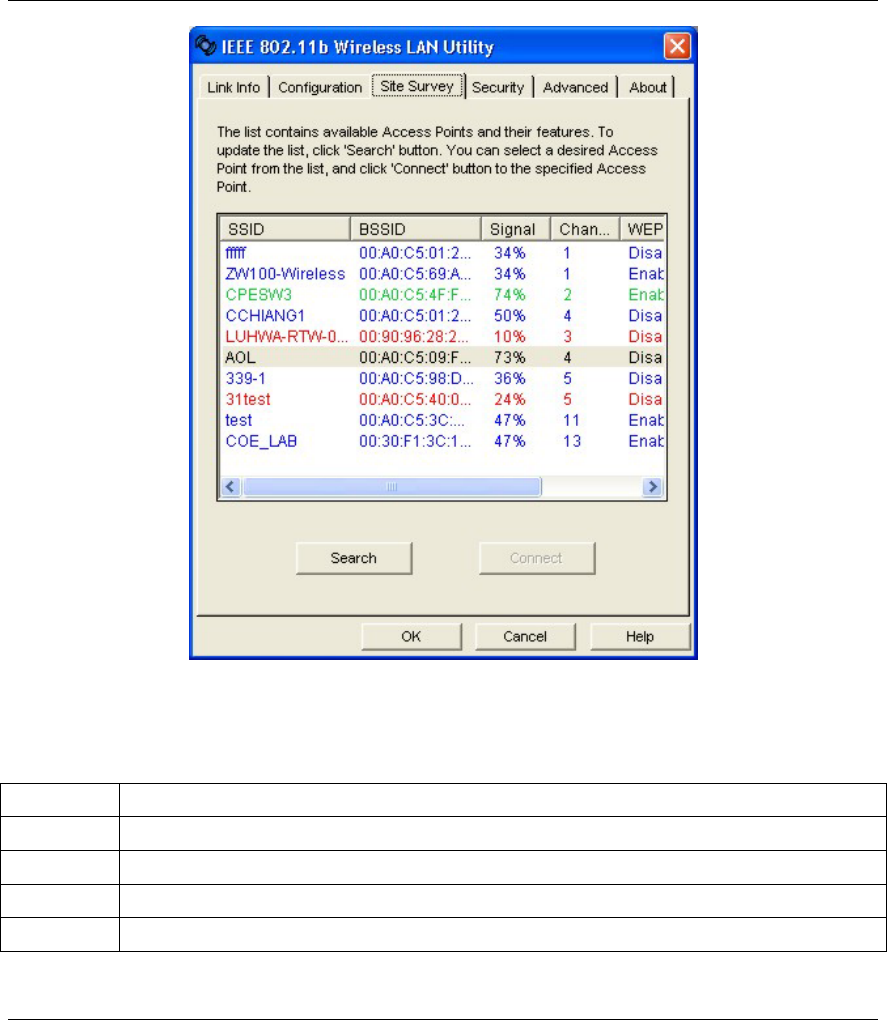
Wireless LAN Utility
Using the Wireless LAN Utility 3-9
Figure 3-8 WLAN Utility: Site Survey
The following table describes the fields in the Available Network table.
Table 3-5 WLAN Utility: Site Survey
FIELD DESCRIPTION
SSID This field displays the SSID (or name) of each wireless network.
BSSID This field displays the MAC address of the wireless network.
Channel This field displays the channel number used by each wireless network.
Signal This field displays the signal strength of each wireless network.
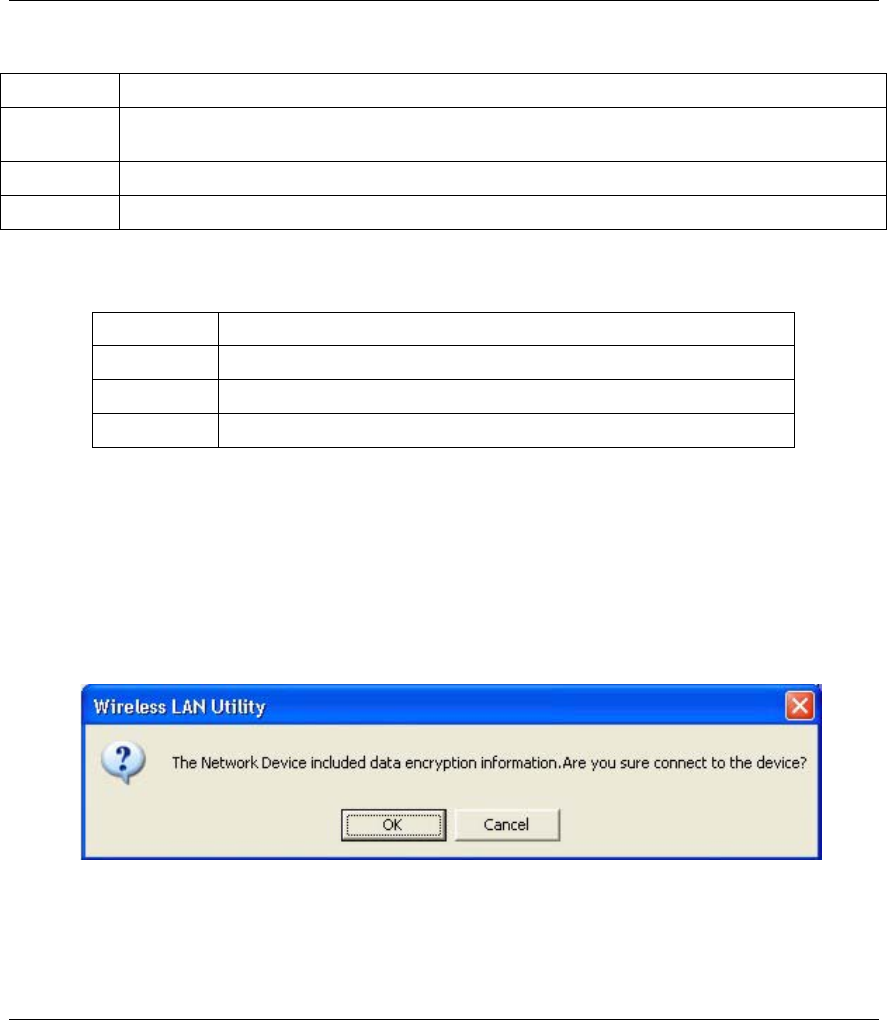
Wireless LAN Utility
3-10 Using the Wireless LAN Utility
Table 3-5 WLAN Utility: Site Survey
FIELD DESCRIPTION
WEP This field shows whether the WEP data encryption is activated (Enable) or inactive
(Disable).
Search Click Search to scan for available wireless device within transmission range.
Connect Click Connect to associate to the selected wireless device.
The following table describes the colors used for the entries in the Site Survey screen.
Table 3-6 Color Indicator for Link Quality/Link Strength
COLOR DESCRIPTION
Green Excellent link quality or link strength.
Blue Good link quality or link strength.
Red Poor link quality or link strength.
3.7.1 Connecting to a Network
Follow the steps below to connect to a network.
Step 1. Click Rescan to scan for all available wireless networks within range.
Step 2. To join a network, either click an entry in the Available Network table to select a wireless
network and then click Connect or double-click an entry.
Step 3. If the WEP Status field is Enable for the selected wireless network, the following screen
displays.
Figure 3-9 Site Survey Warning
Step 4. Click OK to display the Security screen and refer to Section 4.2 to set up WEP keys. Otherwise
click Cancel and connect to another wireless network without WEP encryption.
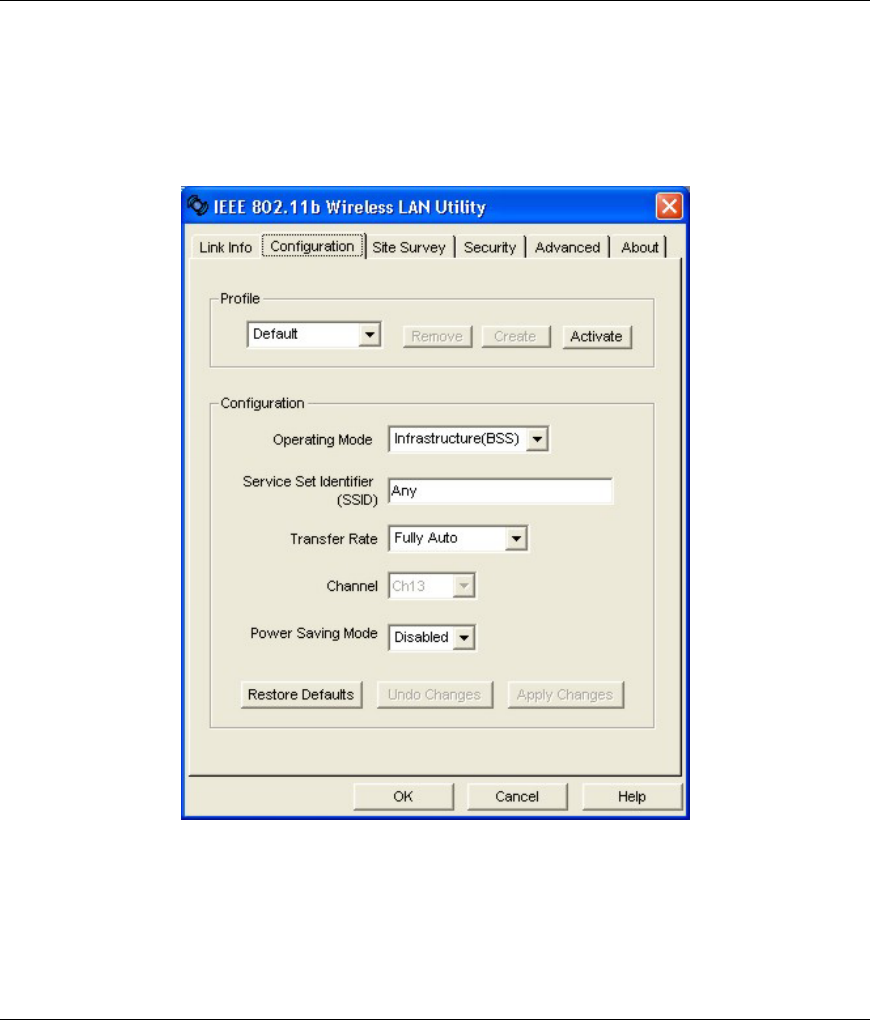
Wireless LAN Utility
Using the Wireless LAN Utility 3-11
Step 5. To verify that you have successfully connected to the selected network, check the network
information in the Link Info screen.
3.8 Configuring the Wireless Parameters
Click Network Configuration in the WLAN Utility program to display the Network Configuration
screen as shown next.
Figure 3-10 WLAN Utility: Network Configuration
Follow the instructions in the table below to configure the wireless LAN related parameters. Refer to the
next section for Profile field descriptions.

Wireless LAN Utility
3-12 Using the Wireless LAN Utility
Table 3-7 WLAN Utility: Network Configuration
FIELD DESCRIPTION
Configuration
Operating Mode Select Infrastructure(BSS) or Ad-Hoc(IBSS) from the drop-down list box.
Select Infrastructure(BSS) to associate to an AP.
Select Ad-Hoc(IBSS) to associate to a peer ad-hoc computer.
Refer to the Wireless Network Type section for more information.
Service Set
Identifier (SSID)
Enter the SSID of the AP or the peer ad-hoc computer to which you want to associate in
this field. To associate to an ad-hoc network, you must enter the same SSID as the peer
ad-hoc computer.
Enter Any to associate to or roam between any infrastructure wireless networks. This is
the default setting.
Transfer Rate Select a transmission speed from the drop-down list box. Choose from Fully Auto
(default), 1M bit/sec, 2M bit/sec, 5.5M bit/sec and 11M bit/sec.
Channel Select the channel number from the drop-down list box. To associate to an ad-hoc
network, you must use the same channel as the peer ad-hoc computer.
Power Saving
Mode
Select Enable from the drop-down list menu to save power (especially for laptop
computers). This forces the WLAN Adapter to go to sleep mode when it is not
transmitting data.
When you select Disable, the WLAN Adapter will never go to sleep mode.
Restore Default Click Restore Default to reset all fields back to factory default values.
Undo Changes Click Undo Changes to start configuring the fields again.
Apply Changes Click Apply Changes to save the changes back to WLAN Adapter.
3.9 Network Configuration Profile Setting
The Profile in the Configuration screen allows you to save the wireless network settings in the
Configuration screen, use one of the pre-configured network profiles or reset the settings in the
Configuration screen to the factory default values.
3.9.1 Resetting to Factory Default Values
To reset the fields in the Configuration screen back to factory default values select Default from the drop-
down list menu and click Activate.

Wireless LAN Utility
Using the Wireless LAN Utility 3-13
3.9.2 Saving the Current Setting to a Profile
To save the current settings in the Configuration screen to a new profile enter a descriptive name in the
field provided and click Create.
3.9.3 Using a Pre-configured Profile
To use a previously saved network profile select the profile file name from the drop-down list box and click
Activate.
3.9.4 Deleting a Profile
To delete an existing wireless network configuration select a profile from the drop-down list box and click
Remove.

Wireless LAN Utility
Wireless LAN Security 4-1
Chapter 4
Wireless LAN Security
This chapter shows you how to set up the wireless LAN security available in the WLAN Adapter.
4.1 Introduction
Wireless LAN security is vital to your network to protect wireless communication between wireless clients
and the wired network.
Configure the wireless LAN security using the Security screen. If you do not enable any wireless security
on your WLAN Adapter, communication between the WLAN Adapter and the wired network is accessible
to any wireless networking device that is in the coverage area.
4.2 Data Encryption with WEP
WEP (Wired Equivalent Privacy) encryption scrambles the data transmitted between the WLAN Adapter
and the AP or other wireless stations to keep network communications private. It encrypts unicast and
multicast communications in a network. Both the wireless clients and the access points must use the same
WEP key for data encryption and decryption.
Your WLAN Adapter allows you to configure up to four 64-bit or 128-bit WEP keys but only one key can
be enabled at any one time.
4.2.1 Authentication Mode
The IEEE 802.11b standard describes a simple authentication method between the wireless clients and AP.
Three authentication modes are defined: Auto, Open and Shared.
Open authentication mode is implemented for ease-of-use and when security is not an issue. The wireless
station and the AP do not share a secret key. Thus the wireless stations can associate with any AP and listen
to any data transmitted plaintext.
Shared authentication mode involves a shared secret key to authenticate the wireless station to the AP. This
requires you to enable a security feature and specify a shared secret key (usually the WEP encryption and
WEP key) on both the wireless station and the AP.
Auto authentication mode allows the WLAN Adapter to switch between the open and shared key
authentication modes automatically. Use the auto mode if you do not know the authentication mode of the
other wireless clients.
4.2.2 Configuring the WEP Encryption
Click the Security tab to display the Security screen as shown below.
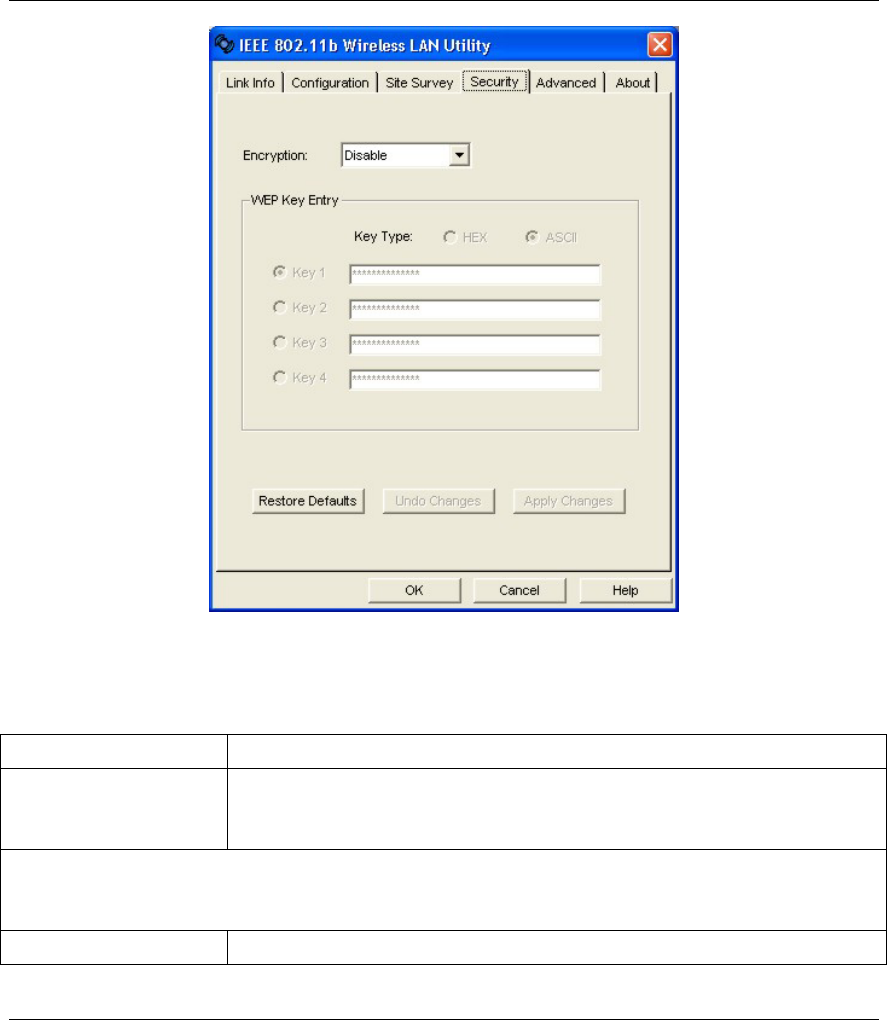
Wireless LAN Utility
4-2 Wireless LAN Security
Figure 4-1 WLAN Utility: Security
Follow the instructions in the table to configure the WEP encryptions.
Table 4-1 WLAN Utility: Security
FIELD DESCRIPTION
Encryption (WEP) Select either 64 Bits or 128 Bits from the drop-down list box to activate WEP
encryption and then fill in the related fields.
Select Disable to deactivate the WEP encryption.
WEP Key Entry
The WEP keys are used to encrypt data before it is transmitted. The values for the keys must be set up
exactly the same on the APs or other peer ad-hoc wireless computers as they are on the WLAN Adapter.
Key Type Select either the HEX or ASCII WEP key type.

Wireless LAN Utility
Wireless LAN Security 4-3
Table 4-1 WLAN Utility: Security
FIELD DESCRIPTION
Key 1 … 4 Enter the WEP keys in the fields provided.
If you select 64 Bits in the Encryption field.
Enter either 10 hexadecimal digits in the range of “A-F”, “a-f” and “0-9”
(e.g. 11AA22BB33) for HEX key type
or
Enter 5 printable ASCII characters (case sensitive) ranging from “a-z”,
“A-Z” and “0-9” (e.g. MyKey) for ASCII key type.
If you select 128 Bits in the Encryption field,
Enter either 26 hexadecimal digits in the range of “A-F”, “a-f” and “0-9”
(for example, 00112233445566778899AABBCC) for HEX key type
or
Enter 13 printable ASCII characters (case sensitive) ranging from “a-
z”, “A-Z” and “0-9” (for example, MyKey12345678) for ASCII key type.
You must configure all four WEP keys the first time you
use the WLAN Adapter.
ASCII WEP keys are case sensitive.
Restore Default Click Restore Default to reset all fields back to factory default values.
Undo Changes Click Undo Changes to start configuring the fields again.
Apply Changes Click Apply Changes to save the changes back to WLAN Adapter.
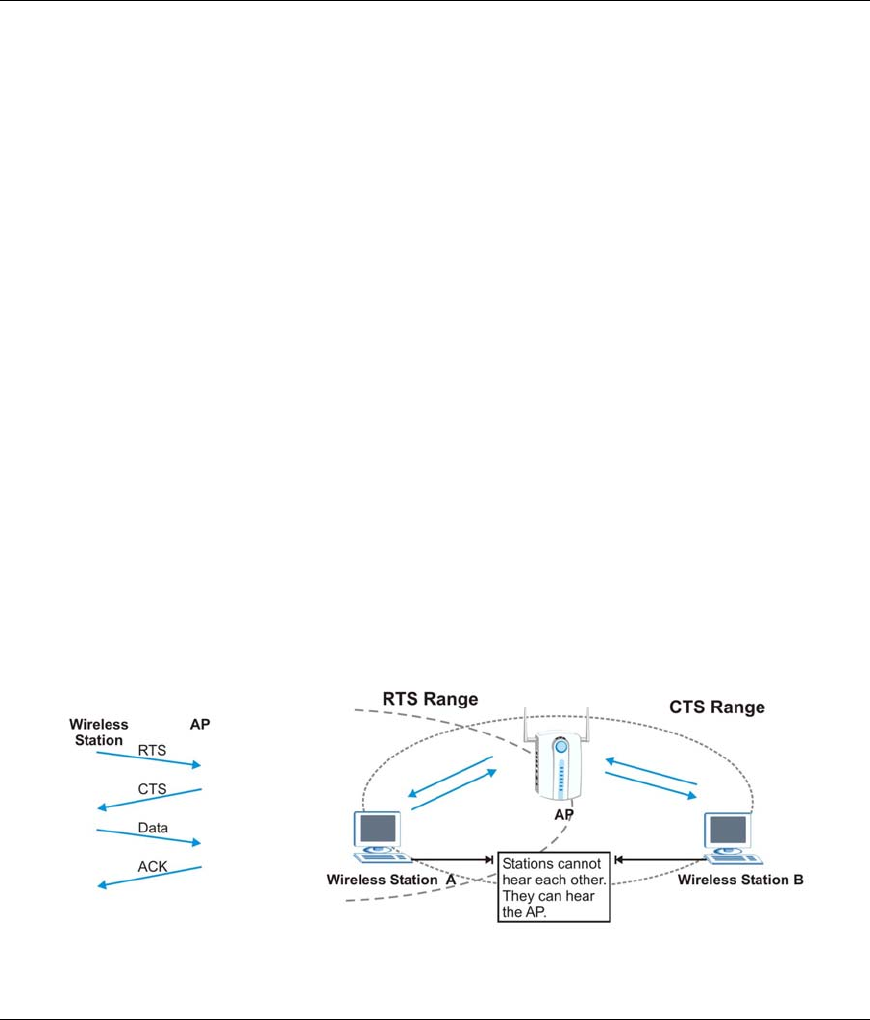
Wireless LAN Utility
Advanced Configuration 5-1
Chapter 5
Advanced Configuration
This chapter shows you how to configure advanced features of the WLAN Adapter.
5.1 Overview
The following sections introduce the advanced features you can configure.
5.1.1 Threshold Control
Fragmentation Threshold
A Fragmentation Threshold is the maximum data fragment size (between 256 and 2432 bytes) that can be
sent in the wireless network before the WLAN Adapter will fragment the packet into smaller data frames.
A large Fragmentation Threshold is recommended for networks not prone to interference while you
should set a smaller threshold for busy networks or networks that are prone to interference.
If the Fragmentation Threshold value is smaller than the RTS/CTS Threshold value (see previously)
you set then the RTS (Request To Send)/CTS (Clear to Send) handshake will never occur as data frames
will be fragmented before they reach RTS/CTS Threshold size.
RTS/CTS Threshold
A hidden node occurs when two stations are within range of the same access point, but are not within range
of each other. The following figure illustrates a hidden node. Both stations are within range of the access
point (AP) or wireless gateway, but out-of-range of each other, so they cannot “hear” each other, that is
they do not know if the channel is currently being used. Therefore, they are considered hidden from each
other.
Figure 5-1 RTS Threshold

Wireless LAN Utility
5-2 Advanced Configuration
When station A sends data to the AP, it might not know that the station B is already using the channel. If
these two stations send data at the same time, collisions may occur when both sets of data arrive at the AP
at the same time, resulting in a loss of messages for both stations.
RTS/CTS Threshold is designed to prevent collisions due to hidden nodes. An RTS/CTS Threshold
defines the biggest size data frame you can send before an RTS (Request To Send)/CTS (Clear to Send)
handshake is invoked.
When a data frame exceeds the RTS/CTS Threshold value you set (between 0 to 2432 bytes), the station
that wants to transmit this frame must first send an RTS (Request To Send) message to the AP for
permission to send it. The AP then responds with a CTS (Clear to Send) message to all other stations within
its range to notify them to defer their transmission. It also reserves and confirms with the requesting station
the time frame for the requested transmission.
Stations can send frames smaller than the specified RTS/CTS Threshold directly to the AP without the
RTS (Request To Send)/CTS (Clear to Send) handshake.
You should only configure RTS/CTS Threshold if the possibility of hidden nodes exists on your network
and the “cost” of resending large frames is more than the extra network overhead involved in the RTS
(Request To Send)/CTS (Clear to Send) handshake.
If the RTS/CTS Threshold value is greater than the Fragmentation Threshold value (see next), then the
RTS (Request To Send)/CTS (Clear to Send) handshake will never occur as data frames will be fragmented
before they reach RTS/CTS Threshold size.
Enabling the RTS Threshold causes redundant network overhead that could
negatively affect the throughput performance instead of providing a remedy.
5.1.2 Authentication Mode
The IEEE 802.11b standard describes a simple authentication method between the wireless clients and AP.
Three authentication modes are defined: Auto, Open and Shared.
Open authentication mode is implemented for ease-of-use and when security is not an issue. The wireless
station and the AP do not share a secret key. Thus the wireless stations can associate with any AP and listen
to any data transmitted plaintext.
Shared authentication mode involves a shared secret key to authenticate the wireless station to the AP. This
requires you to enable a security feature and specify a shared secret key (usually the WEP encryption and
WEP key) on both the wireless station and the AP.
Auto authentication mode allows the WLAN Adapter to switch between the open and shared key
authentication modes automatically. Use the auto mode if you do not know the authentication mode of the
other wireless clients.
5.1.3 Preamble Type
A preamble is a signal used to synchronize the transmission timing in your wireless network. There are two
preamble modes: Long and Short.
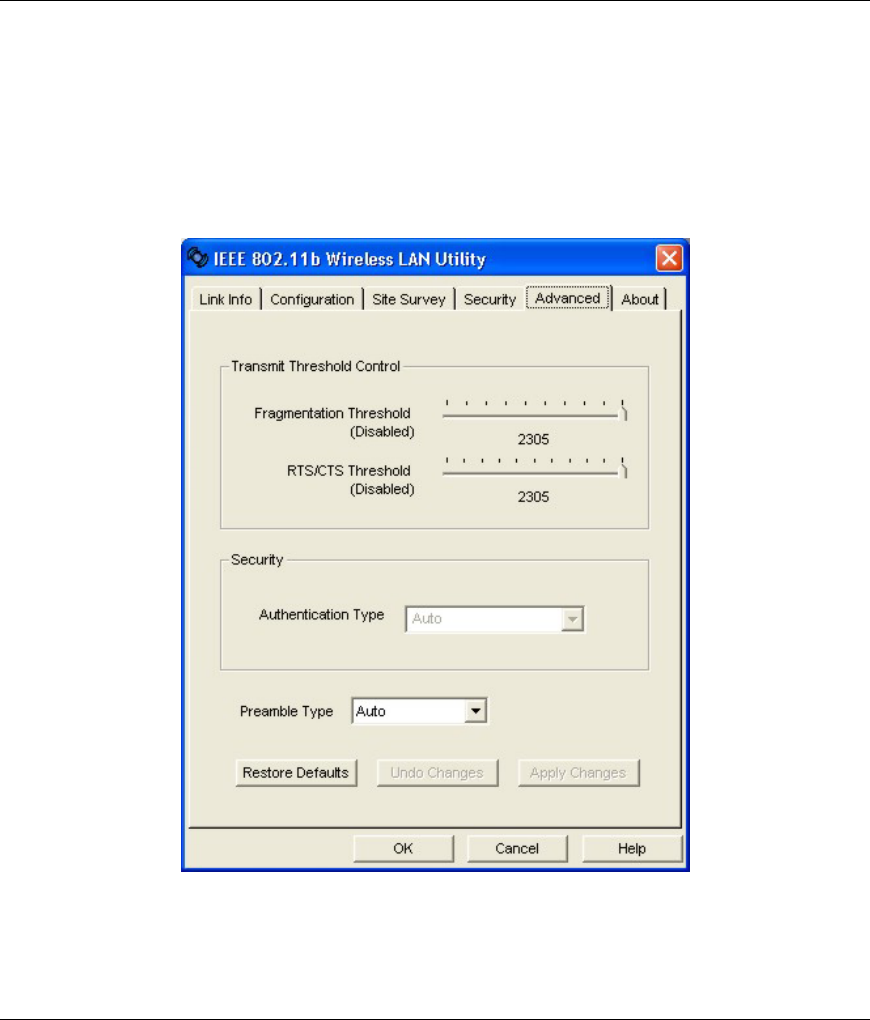
Wireless LAN Utility
Advanced Configuration 5-3
Long preamble mode allows more processing time for each transmitted data packet. Short preamble mode
allows less processing time for the transmitted data packets.
Using short preamble mode may minimize overhead and maximize network throughput. However, short
preamble mode is supported by IEEE 802.11b compliant wireless devices, thus wireless stations using short
preamble mode cannot communicate with wireless stations using the original IEEE 802.11 standard.
5.2 The Advanced Screen
To set the advanced features on the WLAN Adapter, click the Advanced tab.
Figure 5-2 WLAN Utility: Advanced
The following table describes the fields in this screen.

Wireless LAN Utility
5-4 Advanced Configuration
Table 5-1 WLAN Utility: Advanced
FIELD DESCRIPTION
Transmit Threshold Control
Fragmentation
Threshold
The threshold (number of bytes) for the fragmentation boundary for directed
messages. It is the maximum data fragment size that can be sent.
Move the slider to set the fragmentation threshold.
RTS/CTS Threshold Data with its frame size larger than this value will perform the RTS/CTS handshake.
Setting this attribute to be larger than the maximum MSDU (MAC service data unit)
size turns off the RTS/CTS handshake. Setting this attribute to zero turns on the
RTS/CTS handshake.
Move the slider to set the RTS/CTS threshold.
Security
Shared Mode
(Authenticate Access
Point)
Select this checkbox to use a shared key to authenticate the access point.
Refer to Section 5.1.2 for more information.
Preamble Type Select a preamble type from the drop-down list menu. Choices are Long Preamble,
Short Preamble and Auto.
The default setting is Auto.
Refer to Section 5.1.3 for more information.
Restore Default Click Restore Default to reset all fields back to factory default values.
Undo Changes Click Undo Changes to start configuring the fields again.
Apply Changes Click Apply Changes to save the changes back to WLAN Adapter.
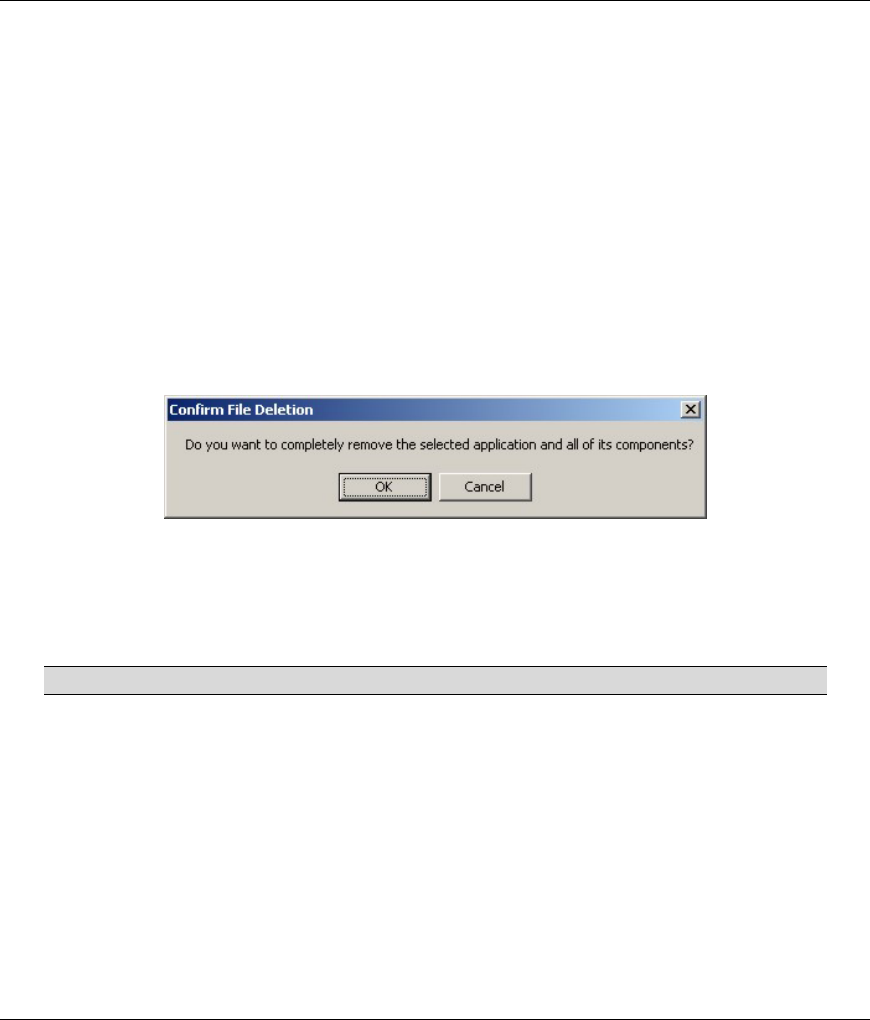
Wireless LAN Utility
Removing and Upgrading the WLAN Utility 6-1
Chapter 6
Removing and Upgrading the WLAN
Utility
This chapter describes how to uninstall or upgrade the WLAN Utility.
6.1 Removing the WLAN Utility
Follow the steps below to remove (or uninstall) the WLAN Utility from your computer.
Step 1. Click Start, Programs, IEEE 802.11bWireless LAN Utility, Uninstall IEEE 802.11b
Package.
Step 2. When prompted, click Yes to remove the driver and the utility software.
Step 3. When prompted to restart your computer, click Yes and then click Finish.
6.2 Upgrading the WLAN Utility
The WLAN Utility continually improves and changes with new driver upgrades. Visit OEM web site to
find the most recent upgrades and information.
Before you uninstall the driver, save the current network configuration.
To perform the upgrade, follow the steps below.
Step 1. Download the latest version of the driver save the file on your computer.
Step 2. Follow the steps in the Removing the WLAN Utility section to remove the current WLAN
Utility from your computer.
Step 3. Restart the computer when prompted.
Step 4. After restarting, refer to the procedure in the Quick Installation Guide to install the new utility
software.
Step 5. Check the version numbers in the About screen to make sure the new driver is installed
properly.

Wireless LAN Utility
Troubleshooting 7-1
Chapter 7
Troubleshooting
This chapter covers potential problems and the possible remedies. After each problem description, some
instructions are provided to help you to diagnose and to solve the problem.
7.1 Problems Starting the WLAN Utility Program
Table 7-1 Troubleshooting Starting WLAN Utility Program
Make sure the WLAN Adapter is properly inserted and the LED(s) is on. Refer
to the Quick Installation Guide for the LED descriptions.
Use the Device Manager to check for possible hardware conflicts.
Click Start, Settings, Control Panel, System, Hardware and Device
Manager. Verify the status of the WLAN Adapter under Network Adapter.
(Steps may vary depending on the version of Windows).
Install the WLAN Adapter in another computer.
Cannot start the WLAN
Utility.
If the error persists, you may have a hardware problem. In this case, you
should contact your local vendor.

Wireless LAN Utility
7-2 Troubleshooting
7.2 Problems Communicating With Other Computers
Table 7-2 Troubleshooting Communication Problems
PROBLEM CORRECTIVE ACTION
The WLAN Adapter
computer cannot
communicate with the other
computer.
A. Infrastructure Make sure that the AP and the associated computers are turned on and
working properly.
Make sure the WLAN Adapter computer and the associated AP use the
same SSID.
Make sure that the computer and the AP share the same security option
and key.
Verify the settings in the Security screen.
B. Ad-Hoc (IBSS) Verify that the peer computer(s) is turned on.
Make sure the WLAN Adapter computer and the peer computer(s) are
using the same SS ID and channel.
Make sure that the computer and the peer computer(s) share the same
security option and key.
Change the wireless clients to use another radio channel if interference is
high.
7.3 Problem with the Link Status
Table 7-3 Troubleshooting Link Quality
PROBLEM CORRECTIVE ACTION
The Link Quality bar
indicator is red all the time.
Move your computer closer to the AP or the peer computer(s) within the
transmission range.
There is too much radio interference (for example microwave) around
your wireless network. Relocate or reduce the radio interference.
The Link Strength bar
indicator is red all the time.
Move your computer closer to the AP or peer computer(s) within the
transmission range.
There is too much radio interference (for example microwave) around
your wireless network. Relocate or reduce the radio interference.

Wireless LAN Utility
Troubleshooting 7-3
Table 7-3 Troubleshooting Link Quality
PROBLEM CORRECTIVE ACTION
The Survey screen displays
all entries in red.
Move your computer closer to the AP or peer computer(s) within the
transmission range.
There is too much radio interference (for example microwave) around
your wireless network. Relocate or reduce the radio interference.

Wireless LAN Utility
Index A
Index
A
Access Point....................................................1-1
Accessing the WLAN Utility..........................3-1
Additional Information to OEM Integrators .....vi
Advanced Configuration .................................5-1
AP .............................................See Access Point
Applications
Ad-hoc ........................................................1-1
Infrastructure...............................................1-2
Authentication Mode............................... 4-1, 5-2
Auto .................................................... 4-1, 5-2
Open.................................................... 4-1, 5-2
Shared ................................................. 4-1, 5-2
Auto authentication mode ....................... 4-1, 5-2
B
Basic Service Set.................................... See BSS
BSS .................................................................3-6
C
Certifications.....................................................vi
Common Screen Command Buttons...............3-3
Communication Problem ................................7-2
Ad-hoc(IBSS) .............................................7-2
Infrastructure...............................................7-2
Connecting to a Network ..............................3-10
Copyright ...........................................................ii
Disclaimer......................................................ii
Trademarks ....................................................ii
CTS (Clear to Send .........................................5-2
Customer Support ............................................vii
D
Data encryption...............................................4-1
E
End Product Labeling........................................vi
ESS..................................................................3-6
Extended Service Set...............................See ESS
F
FCC ....................................................................v
Federal Communications Commission (FCC)
Interference Statement....................................v
Fragmentation Threshold ................................5-1
H
Hidden node ....................................................5-1
I
IBSS ................................................................3-5
Important Note ..................................................vi
IMPORTANT NOTE........................................vi
Independent Basic Service Set .............. See IBSS
Information for Canadian Users........................iv
Caution..........................................................iv
Note...............................................................iv
N
Network Configuration Profile......................3-12
Reset to factory defaults............................3-12
Saving........................................................3-13
Using pre-configured profile.....................3-13
Network Type .................................................3-5
Ad-Hoc(IBSS).............................................3-5
Infrastructure...............................................3-6
Notice.................................................................v

Wireless LAN Utility
B Index
O
Open authentication mode .......................4-1, 5-2
Operating Mode......................See Network Type
P
Power Saving Mode...................................... 3-12
Preamble Mode............................................... 5-2
Long............................................................ 5-3
Short............................................................ 5-3
Preface ............................................................. xii
problem description ........................................ 7-1
Profile
Network Configuration ............................. 3-12
R
Rate
Transmission............................................... 3-5
Related Documentation.................................... xii
Roaming
Example...................................................... 3-7
RTS (Request To Send) ..................................5-2
RTS/CTS handshake....................................... 5-2
RTS/CTS Threshold ....................................... 5-1
S
Shared authentication mode.....................4-1, 5-2
Site Survey...................................................... 3-9
Syntax Conventions......................................... xii
System tray Icon Color Description................ 3-1
T
Transfer Rate ................................................ 3-12
Transmission Speed...................................... 3-12
Troubleshooting.............................................. 7-1
Checking Hardware Conflict ...................... 7-1
Communication problems........................... 7-2
Radio interference................................7-2, 7-3
Starting the WLAN Utility .........................7-1
Survery........................................................7-3
U
Using the WLAN Utility.................................3-1
Note.............................................................3-1
V
Viewing Current Configuration ......................3-2
W
Warranty ...........................................................iii
WEP................................................................4-1
WEP Data Encryption
Configuring.................................................4-1
WEP Data Encryption with.............................4-1
WEP Key ........................................................4-2
Type ............................................................4-2
Wired Equivalent Privacy..................... See WEP
Wireless LAN .................................................1-1
Applications................................................1-1
Benefits .......................................................1-1
Wireless LAN Parameters...............................3-5
Channel .......................................................3-5
Configuring...............................................3-11
Network Type .............................................3-5
SSID............................................................3-5
Tx Rate........................................................3-5
Wireless LAN Security...................................4-1
Data Encryption with WEP.........................4-1
WLAN ....................................See Wireless LAN
WLAN Utility
About ..........................................................3-4
Before you upgrade.....................................6-1
Remove and Upgrade..................................6-1
Removing....................................................6-1
Site Survey..................................................3-9
Upgrading ...................................................6-1
WLAN Status..............................................3-2